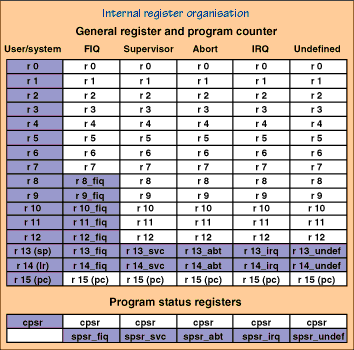ARM7TDMI Characteristics

Operating Modes
The ARM7TDMI has seven operating modes:
- User mode
Unprivileged mode under which most tasks run. - FIQ mode
Entered when a high priority (fast) interrupt is raised. - IRQ mode
Entered when a low priority (normal) interrupt is raised. - Supervisor mode
Entered on reset and when a software interrupt instruction is executed. - Abort mode
Used to handle memory access violations. - Undef mode
Used to handle undefined instructions. - System mode
Privileged mode using the same registers as user mode.
Each operating mode has dedicated banked registers for fast exception handling. These are indicated in blue on the figure above. The FIQ mode has five additional banked working registers, r8_fiq to r12_fiq, to enhance interrupt processing speed. The microcontroller has a total of 37 32-bit registers, including 6 status registers.
ARM7TDMI Structure / ARM7TDMI Instruction Sets






